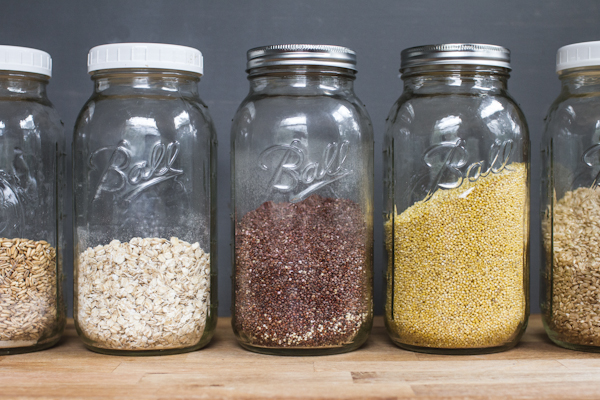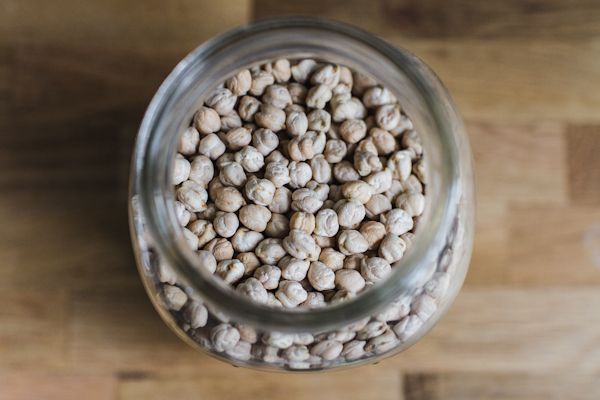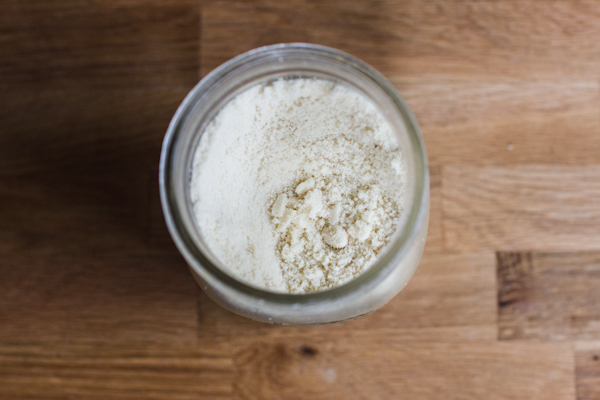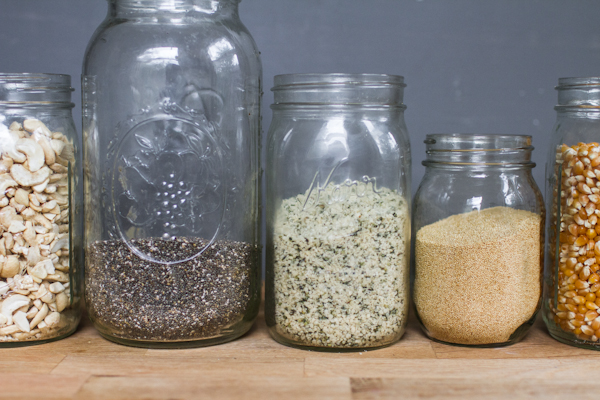As someone who has been living the vegetarian lifestyle for quite a few years now, I’ve been asked many questions about what it’s like to not include meat, fish and meat products in my diet. However, there are two questions that come up time and time again: “What exactly do you eat?” And, my personal favorite, “But where do you get your protein?”
These are the vegetarian staples for a well-balanced diet!
The truth is that eating vegetarian, even if it’s only a few meals a week, can open you up your diet to variety of new, healthy foods. Instead of focusing on limitations, you can focus on finding foods naturally rich in protein, healthy fats and fiber, getting creative with fruits and veggies in the kitchen.

Photos via Edible Perspective
Fruits and vegetables:
How could we start with anything else? This list is a mile long and plays a key role in delivering the daily nutrients my body needs and craves. Fruits and vegetables are loaded with all sorts of vitamins, minerals, fiber, and some even have protein. I aim to eat a large variety each week to make sure I’m filling my body with everything I need.
- Fruits: apples, pears, peaches, nectarines, plums, cherries, grapes, lemons, limes, apricots, pineapple, avocados, watermelon, cantaloupe, honeydew, kiwi, blueberries, strawberries, mango, raspberries, blackberries, tomatoes, bananas, dates, figs
- Vegetables: kale, spinach, collards, chard, broccoli, cauliflower, zucchini, butternut squash, acorn squash, snap peas, green beans, green peas, corn, cucumbers, radishes, carrots, eggplant, peppers, pumpkin, mushrooms, cabbage, romaine, butter lettuce, onions, fennel, beets

Grains
I’m not sure what I would do without grains. They’re included in almost every meal I eat and help keep me satiated throughout the day. Grains really help in bulking up a vegetarian meal. My preference is to buy dry grains in bulk and cook them as needed. They can typically be stored in the fridge after cooking for about 4-5 days. Grains are typically an excellent source or protein and fiber, but some boast higher nutritional values than others.
- Oats – This is one of my breakfast staples. I cook a variety of different types of oats but they are all processed from the whole oat groat. (Psst! Check out this post to learn about the different types of oast!)
- Millet – I use millet for both sweet and savory recipes. It’s similar to quinoa in how it cooks but has a heavier, thicker texture. The flavor is mild and nutty.
- Brown Rice – While I cook with many different types of rice, short grain brown rice is my favorite.
- Quinoa – This ancient grain gets used each and every week in my kitchen. It cooks in about 15 minutes and has a light and fluffy texture with a nutty and also earthy flavor.
- Other favorites – cornmeal, buckwheat, farro, and amaranth
Potatoes:
Potatoes kind of float in between the starch and vegetable list. No matter which column you think they belong under, they are filled with rich nutrients and play a key role in the vegetarian diet.
- Common Potatoes: sweet potatoes, yukon gold potatoes, russet potatoes, red potatoes, fingerling potatoes, new potatoes

Legumes:
These little gems are an excellent plant-based source of protein and fiber. A typical 1/2 cup serving of beans will get you around 5-7 grams of fiber and 7-8 grams of protein, and lentils will get you even more! I always have a few cans of pre-cooked beans on hand, but I prefer to buy dried beans in bulk and cook them in large batches. It’s a total money saver and then you easily avoid BPA from the cans.
- Chickpeas/Garbanzo Beans – These are my favorite bean and probably the most versatile in my kitchen. I use them in everything from veggie burgers to salads and even eat them straight from the bowl.
- Black Beans – My go-to bean when cooking Mexican food!
- Red Beans – Red beans are larger in size and the perfect hearty bean to add to your chili.
- Beluga Lentils – I love the small size of these lentils and that they only take about 20 minutes to cook. Their texture holds up really well in anything you add them to.
- Red Lentils – These lentils are commonly used when creating thick soups, as their texture breaks down and turns soft once cooked. They’re used frequently in ethnic cooking.
- Edamame – Edamame are soybeans, straight from the soybean pod. You typically find these on the menu at sushi restaurants but they’re incredibly easy to prepare at home. You can eat them straight from the pod sprinkled with salt or pop them out and add them to salads and stir fry.

Flours:
I am a huge fan of baking, from breads to doughnuts, and keep many different types of flours in my kitchen at all times. I also buy a lot of the whole grains in bulk and grind them into flour right at home. This delivers the most nutrients and freshest flavors to the items I’m baking or cooking.
- Common Flours [contain gluten] – whole wheat flour, whole wheat pastry flour, while-whole wheat flour, spelt flour
- Common Gluten-Free Flours – oat flour, buckwheat flour, brown rice flour, tapioca flour [starch], sorghum flour, millet flour, quinoa flour, corn flour
- Common Nut Flours [also gluten-free] – almond meal/flour, coconut flour, hazelnut meal, cashew meal
Oils and Fats:
- Butter – I use butter mainly as a topping as it has a tendency to burn at medium to high temperatures.
- Ghee – Ghee is clarified butter, which is essentially a purer and richer form of butter. It can be used at high heats and is excellent for sauteing and roasting vegetables.
- Extra Virgin Olive Oil – I use this oil when cooking at low to medium temperatures or for dressing a salad, using in homemade pesto, or drizzling on roasted vegetables.
- Unrefined Coconut Oil – This is one of my very favorite oils that I not only use in the kitchen but for DIY skincare products as well!
- Refined Avocado Oil – A fantastic high heat cooking oil.
- Hemp Oil – An oil that should be stored in the fridge and never heated. This is my go-to salad dressing oil and it offers a rich, seedy and earthy flavor.
Nuts and Seeds:
I consume nuts and seeds every single day. They can both be ground into flours and used in gluten-free baking. They can also be added to salads, granola, granola bars, breads, muffins, and used as toppings on salads, oatmeal, and the list goes on. They’re booming with healthy fats, protein, fiber, and other vital nutrients and will definitely help satiate you and keep you feeling balanced throughout the day. Another reason I love nuts and seeds is because you can turn them into nut [or seed] butter! Peanut butter is still my favorite.
- Nuts – almonds, cashews, walnuts, pistachios, peanuts, pecans, pine nuts
- Seeds – hulled hemp seeds, pumpkin seeds [pepitas], sunflower seeds, flax seeds, chia seeds

Protein:
Ahhh, the one you’ve been waiting for. Well, this list is somewhat short but that’s because most of the protein-heavy foods have already been discussed above! That said, there are a few vegetarian protein staples that I eat on a very frequent basis.
- Eggs – Probably one of my top 5 favorite foods. I eat eggs pretty much every single day. One large egg has only 70 calories and about 6 grams of protein. Not too shabby!
- Tofu – While you may be a skeptic of tofu it’s most likely due to the way it was prepared. There is a learning curve for tofu but when done right it’s an excellent addition to many different recipes. I like to keep the soy consumption to about 2 servings per week and always make sure I’m choosing non-GMO soy products. My favorite prep method is grilled tofu, but it can be used in baking, sauces, ethnic dishes and so much more!
- Tempeh – This is a fermented soy product that has a much denser texture than tofu. It holds up very well when cooked and is excellent in chili, tacos, and other hearty dishes.
- Greek Yogurt – I don’t eat a ton of dairy, but I do include full-fat, organic Greek yogurt in my weekly diet. I always choose the plain variety to avoid added sugars, and full-fat to keep my body satiated for a longer period of time.
- Protein Powders – I generally try to get my protein from whole-food sources, but sometimes I need an extra boost. I look for brands that offer minimal ingredients, with no fillers or additives. They typically include things like brown rice protein, pea protein, and can also include protein from sprouted grains and seeds.

Other vegetarian staples:
- Nut Butters: peanut butter, almond butter, cashew butter, tahini, coconut butter
- Sauces, etc: tamari, tomato paste, whole canned tomatoes, hot sauce, salsa, chia seed jam, apple cider vinegar
- Milks: coconut milk, almond milk, soy milk, half and half, whole milk
- Sweeteners: pure maple syrup, raw honey, coconut sugar, muscovado sugar, medjool dates
- Snacks: non-GMO tortilla chips, salted nuts, granola, rice cakes, dark chocolate
- Cheese: cheddar, parmesan, pepper jack, mozzarella, goat, cottage cheese, ricotta *Be sure to seek out cheese that is free of animal based rennet for a true, vegetarian cheese.
The only thing missing? Meat and fish, so really, not much at all!

Share tips, start a discussion or ask one of our experts or other students a question.
No Responses to “What Do You Eat? The Staples of a Vegetarian Diet”